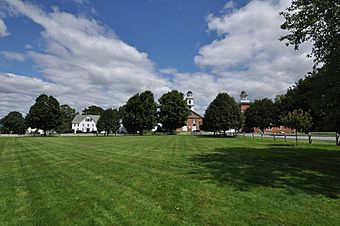Haverhill Corner Historic District facts for kids
Quick facts for kids |
|
|
Haverhill Corner Historic District
|
|
 |
|
| Location | Haverhill, New Hampshire, along NH 10 from Piermont to northern intersection with NH 25; includes Court St. from NH 10 to approx. ½ mile east |
|---|---|
| Area | 544 acres (220 ha) |
| Architect | Multiple |
| Architectural style | Greek Revival, Late Victorian, Federal |
| NRHP reference No. | 87001415 |
| Added to NRHP | August 27, 1987 |
The Haverhill Corner Historic District is a special part of Haverhill, New Hampshire, in the United States. It was once the main center for important town activities. This historic area is found where New Hampshire Route 10 meets Court Street. Long ago, Court Street was a very important road.
Around this meeting point, you'll see two big grassy areas called commons. These commons are surrounded by School Street and Route 10. Many old buildings, mostly from the late 1700s and early 1800s, stand around these green spaces. These buildings often show a style called Federal architecture.
Some famous buildings here include the First Congregational Church, built in 1827. There's also a building from 1840 that used to be a courthouse. Today, it's the public library and a local history museum. You can also see the Haverhill Academy Junior High School building from 1897, which has a Romanesque Revival style.
Over time, this area became less important because the railroad was built somewhere else. Many town services slowly moved to the Woodsville area. In 1987, the Haverhill Corner Historic District was added to the National Register of Historic Places. This means it's recognized as a very important historical site.
Contents
Welcome to Haverhill Corner!
Haverhill Corner is a fascinating place where you can step back in time. It shows how towns in New Hampshire grew many years ago. This district is like a living museum, filled with buildings that tell stories.
What Makes It Special?
The buildings in Haverhill Corner are special because of their old styles. Many are in the Federal style, which was popular in the United States after the American Revolution. These buildings often look grand and balanced. You might also spot some Greek Revival buildings, which look like ancient Greek temples. Later, some Victorian buildings were added, with more decorative details.
Important Buildings to See
- First Congregational Church: Built in 1827, this church is a great example of Federal architecture. It has been a central part of the community for nearly 200 years.
- Old Courthouse (now Library and Historical Society): This building from 1840 used to be where important legal decisions were made. Now, it's a place for learning and discovering local history.
- Haverhill Academy Junior High School: Built in 1897, this school building has a unique Romanesque Revival look. It shows how building styles changed over time.
A Look Back in Time: How Haverhill Corner Started
Haverhill was one of the first big settlements in northern New Hampshire. It was founded in 1763 by soldiers who fought in the French and Indian War. They saw that the land was good for farming. The oldest houses in the district were built around 1769, before the American Revolutionary War began.
When Grafton County was created in 1769, Haverhill was chosen as its shire town. This means it was the main town where the county government was located. It still holds this role today. Early town buildings were placed here. This area also became the end point of a major road that went through New Hampshire. This road is now known as Court Street in Haverhill.
In the early 1800s, Haverhill Corner became a busy county center. It had places for travelers to stay, called taverns. Many lawyers also had their homes and offices here. The academy building, built in 1813, even served as the courthouse for many years.
Why the Railroad Changed Things
In the mid-1800s, a big decision was made. The railroad was built in Woodsville, not Haverhill Corner. This meant that businesses and county services slowly started to move to Woodsville. Haverhill Corner became less important for daily business.
In the 1900s, Haverhill Corner became a popular spot for summer homes. A person named Mildred Page, who lived there for a long time, left money to help keep the village's historic buildings in good shape. Thanks to people like her, we can still enjoy this special place today.



